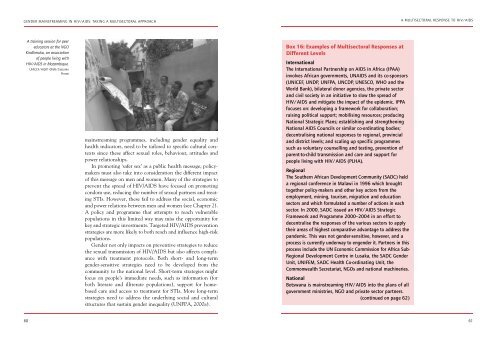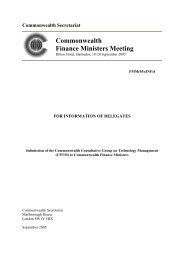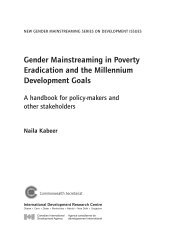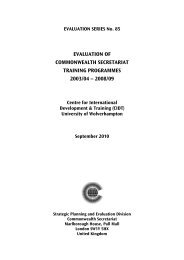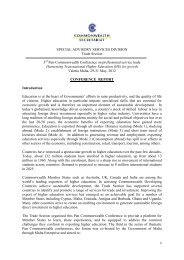Gender Mainstreaming in HIV/AIDS - Commonwealth Secretariat
Gender Mainstreaming in HIV/AIDS - Commonwealth Secretariat
Gender Mainstreaming in HIV/AIDS - Commonwealth Secretariat
Create successful ePaper yourself
Turn your PDF publications into a flip-book with our unique Google optimized e-Paper software.
GENDER MAINST R E A M I NG IN <strong>HIV</strong>/<strong>AIDS</strong>: TA K I NG A MULT I S E C TORAL APPROACH<br />
A tra<strong>in</strong><strong>in</strong>g session for peer<br />
educators at the NGO<br />
K<strong>in</strong>dlimuka, an association<br />
of people liv<strong>in</strong>g with<br />
<strong>HIV</strong>/<strong>AIDS</strong> <strong>in</strong> Mozambique.<br />
UNICEF/HQ01-0168/Giacomo<br />
Pirozzi<br />
ma<strong>in</strong>stream<strong>in</strong>g programmes, <strong>in</strong>clud<strong>in</strong>g gender equality and<br />
health <strong>in</strong>dicators, need to be tailored to specific cultural contexts<br />
s<strong>in</strong>ce these affect sexual roles, behaviour, attitudes and<br />
power relationships.<br />
In promot<strong>in</strong>g ‘safer sex’ as a public health message, policymakers<br />
must also take <strong>in</strong>to consideration the different impact<br />
of this message on men and women. Many of the strategies to<br />
prevent the spread of <strong>HIV</strong>/<strong>AIDS</strong> have focused on promot<strong>in</strong>g<br />
condom use, reduc<strong>in</strong>g the number of sexual partners and treat<strong>in</strong>g<br />
STIs. However, these fail to address the social, economic<br />
and power relations between men and women (see Chapter 2).<br />
A policy and programme that attempts to reach vulnerable<br />
populations <strong>in</strong> this limited way may miss the opportunity for<br />
key and strategic <strong>in</strong>vestments. Targeted <strong>HIV</strong>/<strong>AIDS</strong> prevention<br />
strategies are more likely to both reach and <strong>in</strong>fluence high-risk<br />
populations.<br />
<strong>Gender</strong> not only impacts on preventive strategies to reduce<br />
the sexual transmission of <strong>HIV</strong>/<strong>AIDS</strong> but also affects compliance<br />
with treatment protocols. Both short- and long-term<br />
gender-sensitive strategies need to be developed from the<br />
community to the national level. Short-term strategies might<br />
focus on people’s immediate needs, such as <strong>in</strong>formation (for<br />
both literate and illiterate populations), support for homebased<br />
care and access to treatment for STIs. More long-term<br />
strategies need to address the underly<strong>in</strong>g social and cultural<br />
structures that susta<strong>in</strong> gender <strong>in</strong>equality (UNFPA, 2000a).<br />
Box 16: Examples of Multisectoral Responses at<br />
Different Levels<br />
International<br />
Regional<br />
National<br />
cont<strong>in</strong>ued on page 62<br />
A MULT I S E C TORAL RESPONSE TO <strong>HIV</strong>/<strong>AIDS</strong><br />
60 61


